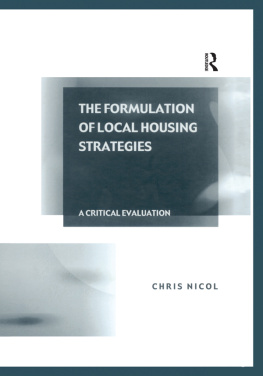Context
This study comprehensively examines the housing market as it existed in the 1990s, with a particular focus upon the manner in which local authorities both formulated housing strategies and monitored housing needs and demands. The 1990s provided an interesting period for such an examination. Not only were housing pressures becoming more complex with uncertain demographic projections and changes in household formation, but there was also a return to integrated housing strategies, a policy that had first developed in the 1970s.
This research arises from a general question as to whether or not the provision of housing efficiently and effectively meets the demands and needs of the population. At the time there existed significant debate regarding this issue (Ball, 1996) and the related area of housing needs estimation. (National Housing Forum, 1989; DoE, 1991a; 1995a; Whitehead and Kleinman, 1992; Holmans, 1995) and is still an issue now as we enter a new decade (Bramley, Pawson and Parker, 2000; Holmans, Kiddle and Whitehead, 2000).
One question, examined hitherto to only a limited degree, is the extent to which local authorities can facilitate and contribute to the structure of more integrated and responsive housing provision through housing strategies (Audit Commission, 1992; Cole and Goodchild, 1993; DoE, 1995c). As housing strategies are central to this discussion, it is necessary to focus upon what is meant by this descriptive term ( contains a fuller discussion) and a housing strategy is seen as an approach by a local authority to achieve three related objectives;
- To develop housing polices which reflect all tenures.
- To reflect the views of the diversity of different participants in the housing market.
- To ensure that policy and implementation are better co-ordinated.
It is this notion of strategy that has been advocated in government advice, and which may be seen as being a return to the initial concepts of Housing Investment Programmes (HIPs), which will be discussed later.
To achieve these objectives, the manner in which local authorities develop links with private housebuilding companies is clearly relevant, as is the degree to which authorities overcome departmentalism in the preparation of polices which direct housing provision. To clarify these issues, it is worthwhile briefly discussing housing provision, stressing why it is necessary for private housebuilders to be included in the formulation of housing strategies.
Currently and throughout much of the last decade, over 80% of all new homes are constructed by the private sector and public sector completions rarely rise above 35,000 homes per annum (see ) explicitly referred to the need for a local authority to examine the contribution to the supply of housing that could be made by the speculative housebuilding industry.
It has to be stressed that new housing supply is relatively limited in relation to the overall housing market. For instance, in 1994 less than 1% of the housing stock was newly built properties (CML/BSA,1996). By the end of the 1990s this had reduced to around 0.75% (Wilcox, 2000, Table 17c). One alternative to new build may be the conversion of existing properties, either from other uses into housing or from an extensive housing use to one which is more intensive. Both of these options have been discussed in recent years by amongst other Lord Rogers in the publication Towards an Urban Renaissance (Urban Task Force, 1999) and then more practically the DETR report Conversion and Redevelopment: Processes and Potential (DETR, 2000).
Even in respect of social housing, private housebuilding companies are important. For instance, as direct social housing provision by local authorities has declined (see The form that this type of social housing will take varies greatly, ranging from low-cost sale, through cross-subsidy developments, to homes for rent in co-operation with housing associations (Dunmore, 1992). Affordable housing provision by the private sector has been supported by central government through a number of different Planning Policy Guidance Notes and policy circulars and this continued to develop throughout the late 1990s (DoE, 1991f; DoE, 1992a; DETR, 1998; DETR, 2000).
Before moving on to examine the implications for housing provision, it is necessary to point out one further factor that complicated the housing market of the 1990s. Of the 35,000 social housing units annually completed, an increasing proportion are provided by housing associations. indicates that, in 1990, housing association and public sector housing completions were almost equal. This situation altered considerably, in the early 1990s so that by 1994 housing associations completed 12 units to every 1 completed by the public sector. By the end of the 1990s the situation was even more pronounced with 1 local authority home being constructed for every 50 housing association units (Wilcox, 2000, Table 19k).
Clearly, the situation that existed in the 1990s, and one would argue continues to exist presently, is one where the development of housing policy is disconnected from its implementation. For instance, a local authority produces policies which attempt to direct housing investment, yet it is left to the strategies of other agencies (private housebuilders and housing associations)relationships, which may create a situation of poor integration in terms of policy and implementation.
Of crucial importance for housing strategies is the accurate determination of housing demand and need, particularly the manner in which this can be determined at a local level (see ). This can be seen at two separate levels. The first is in terms of overall housing requirements. The second level is the determination of the degree to which these households will require certain house types, certain locations, and certain tenures. Whilst the issue of global housing need has been comprehensively examined (Dorling, 1991; King, 1991; Shaw, 1993; Champion, 1993; Holmans, 1995) in recent years, the latter issue has been somewhat neglected. This work develops the debate regarding co-operation and collaboration through the inclusion of a field of study which has been the focus of limited research, namely methods by which local authorities can effectively monitor housing markets at the local level (Coopers and Lybrand 1985c; Coopers and Lybrand, 1987; Guillou, 1990; Scottish Homes 1993; Maclennan et al., 1998).










